
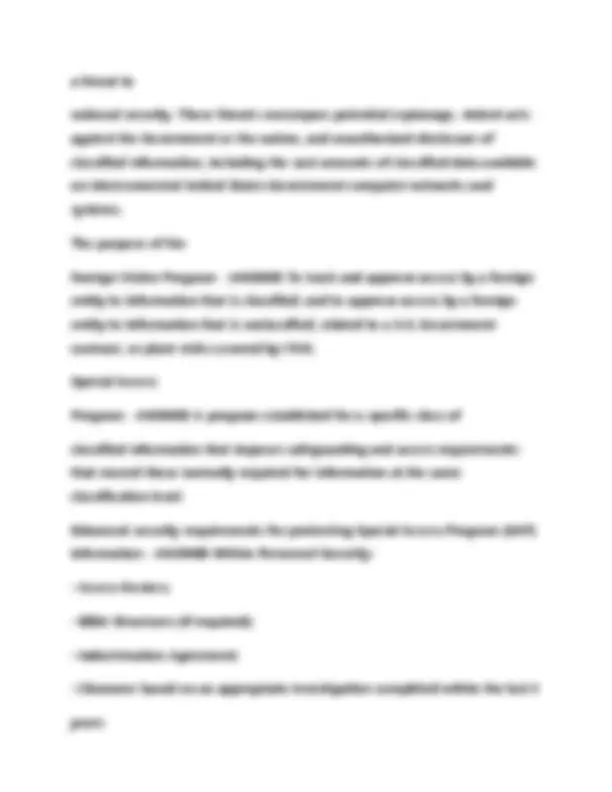
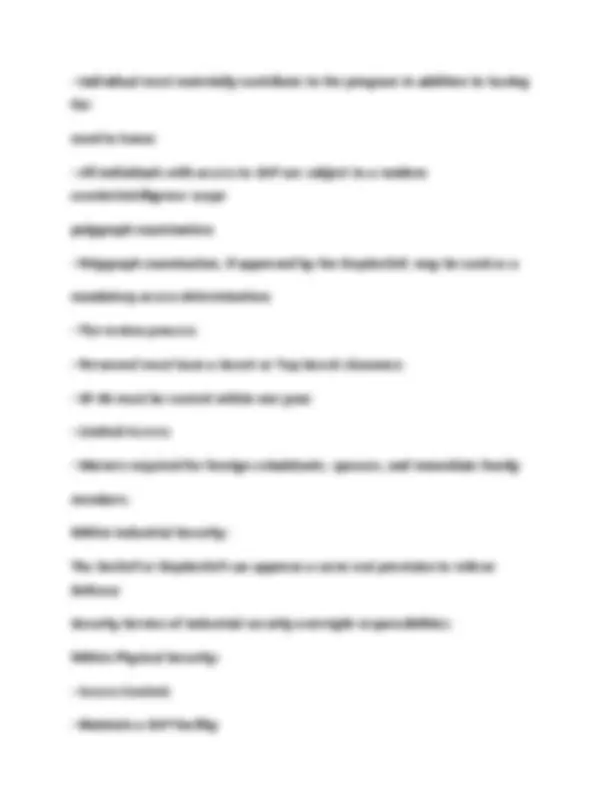
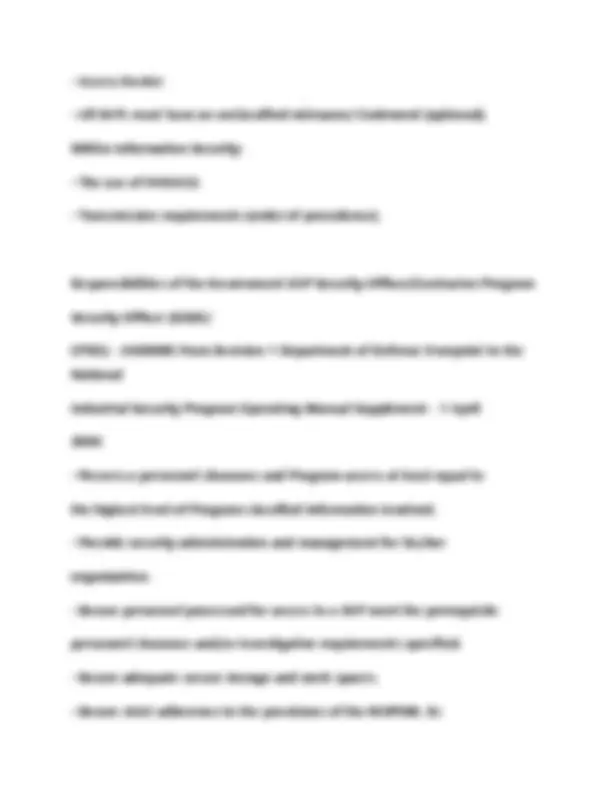
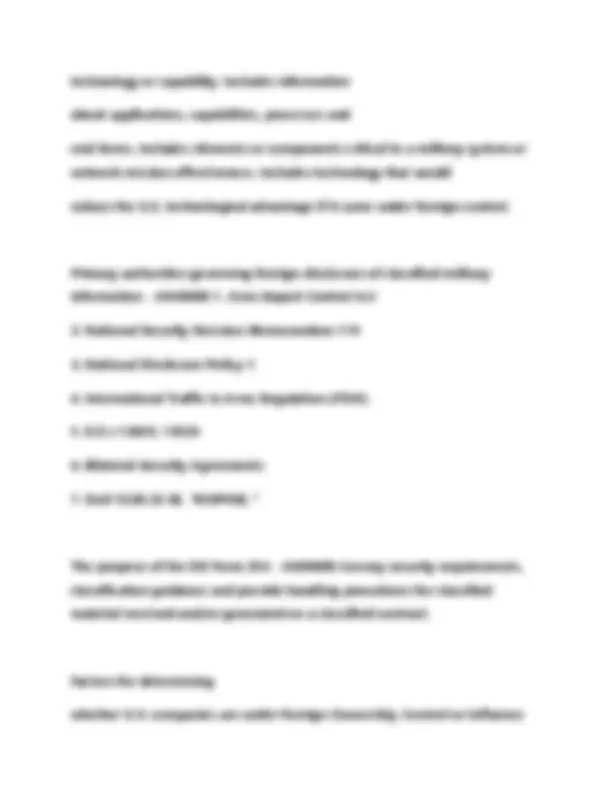
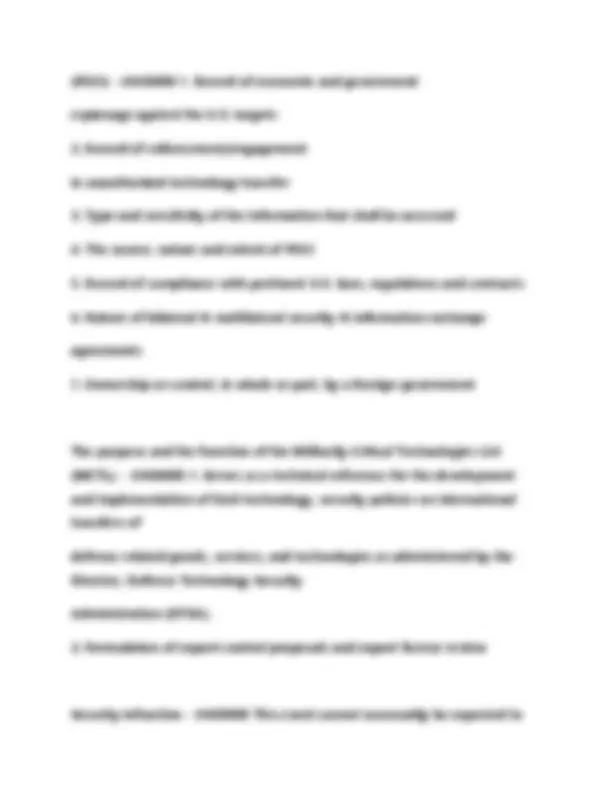
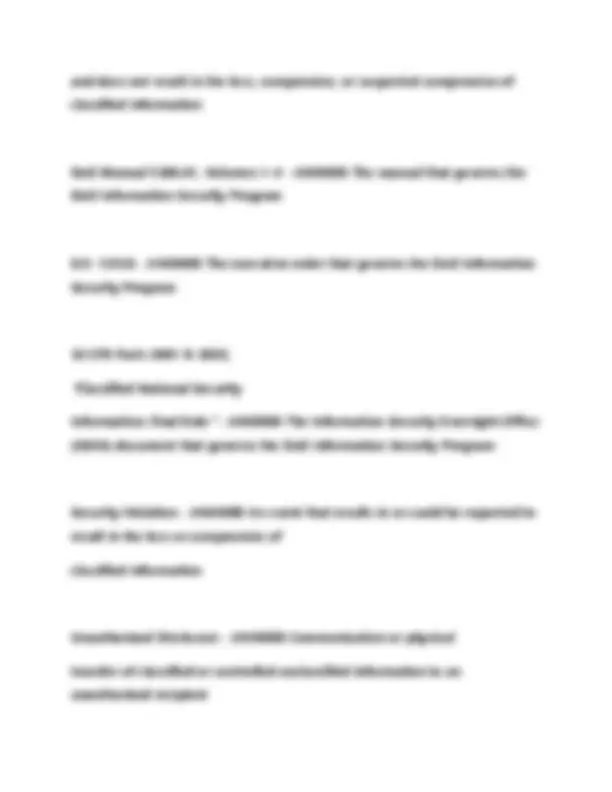
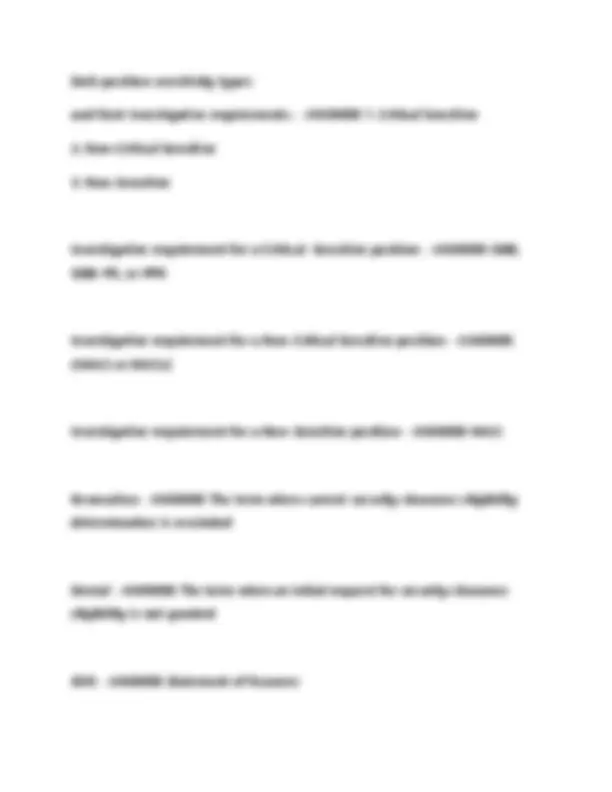
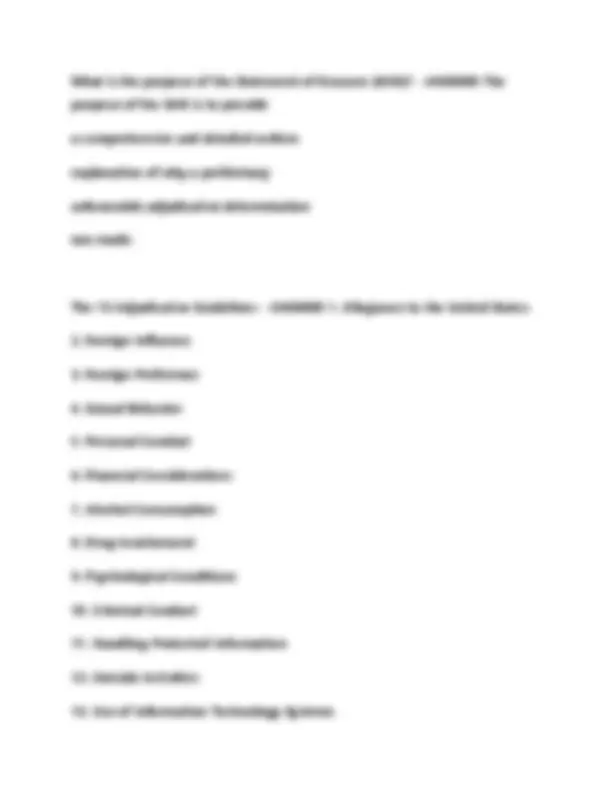

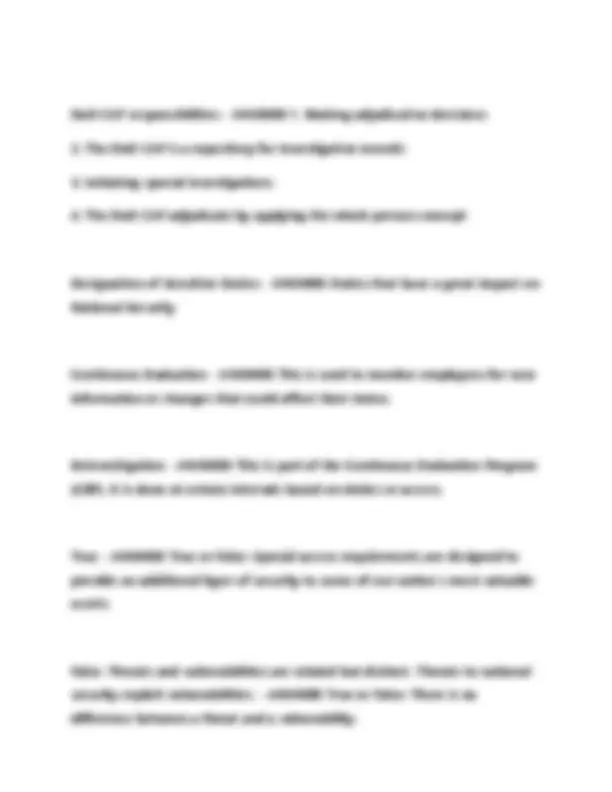
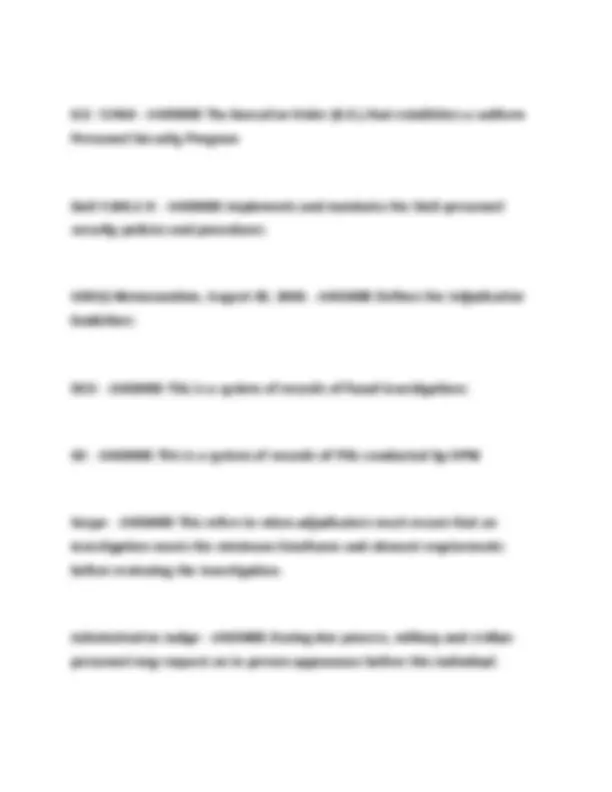

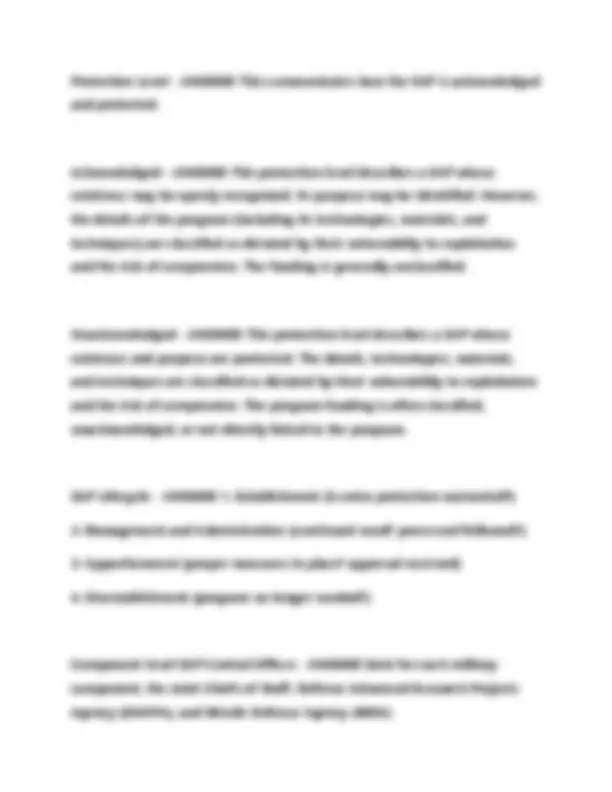
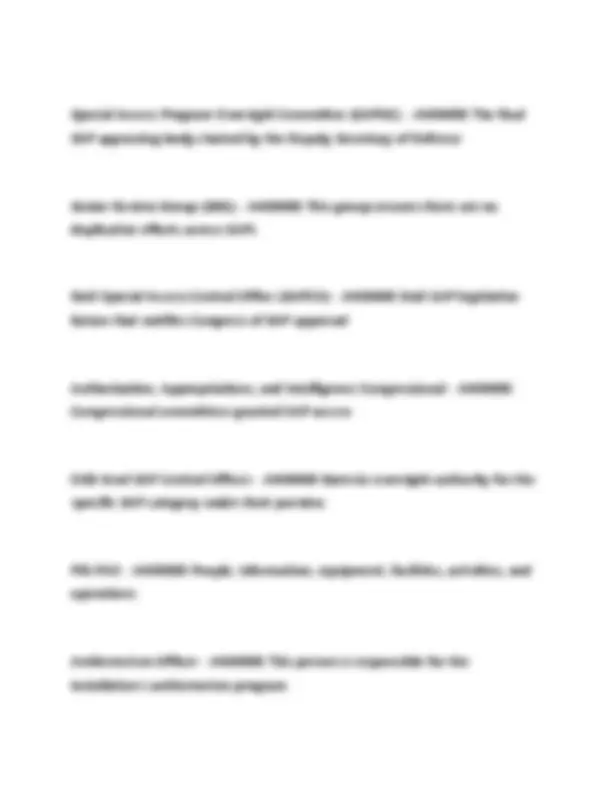
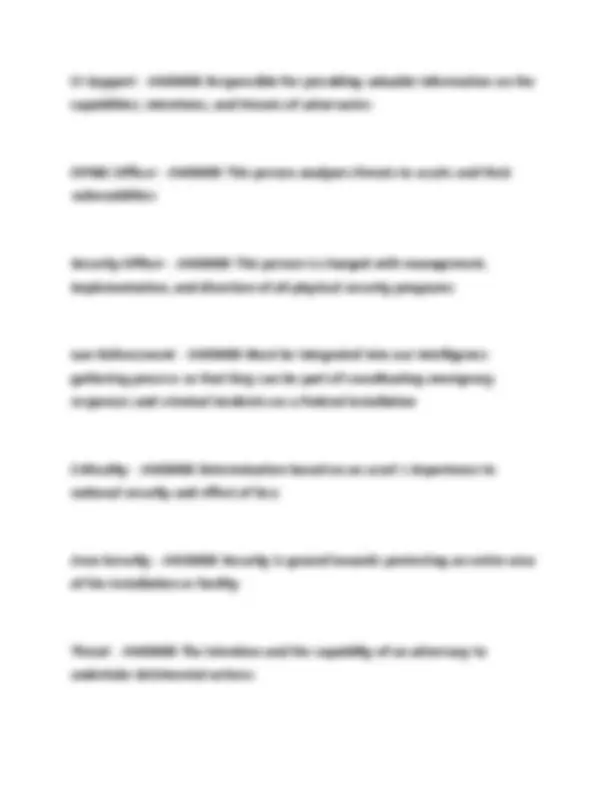
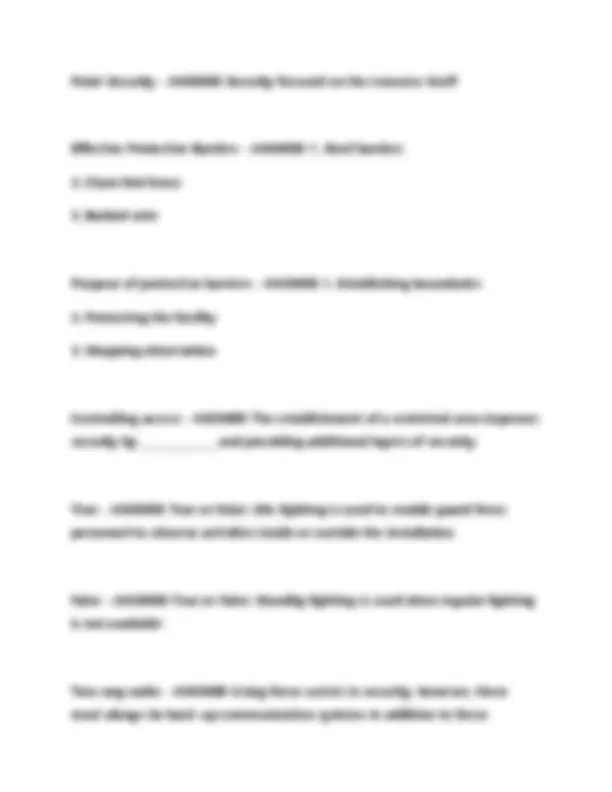


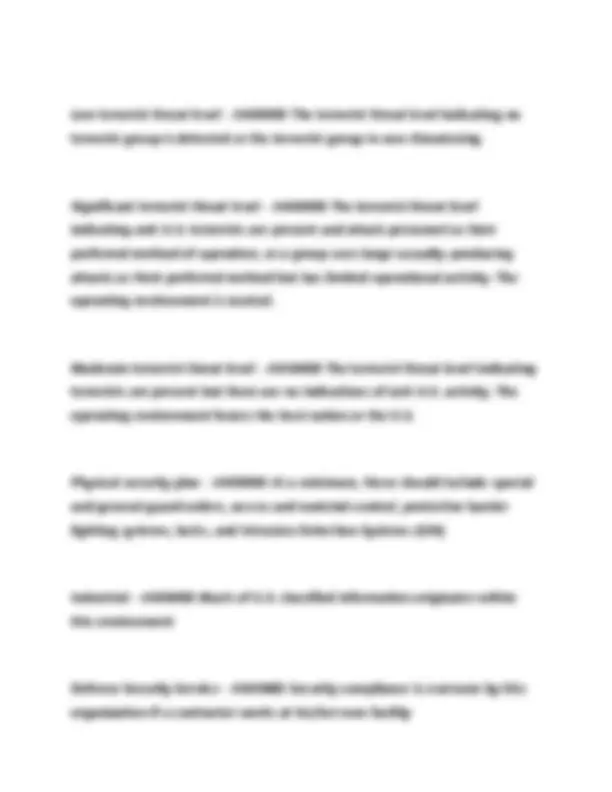
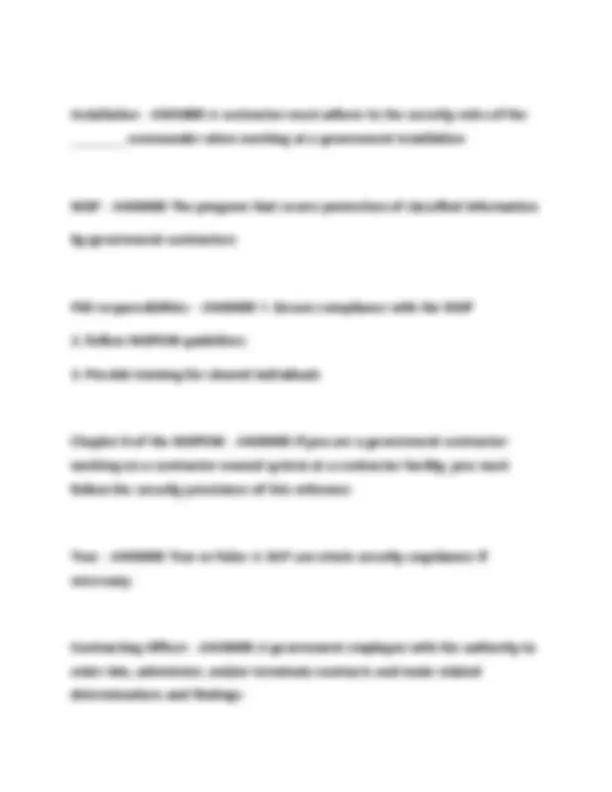
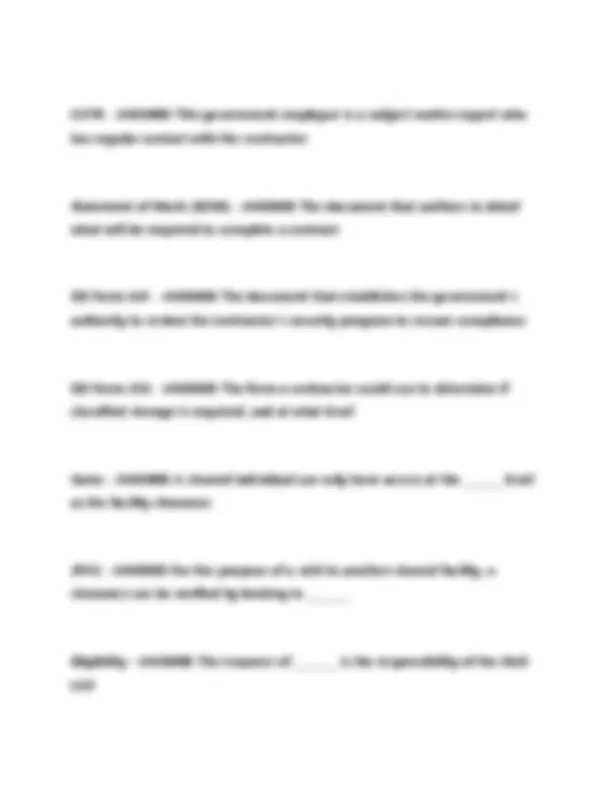
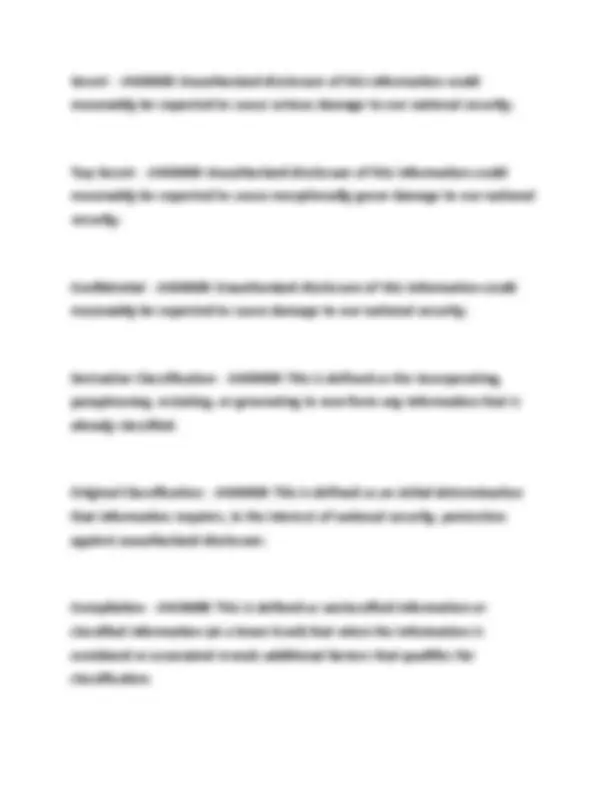

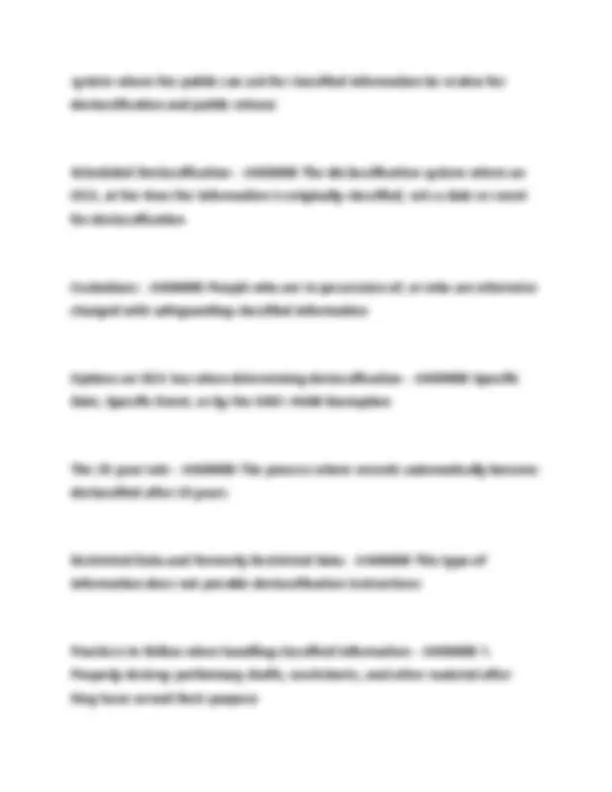
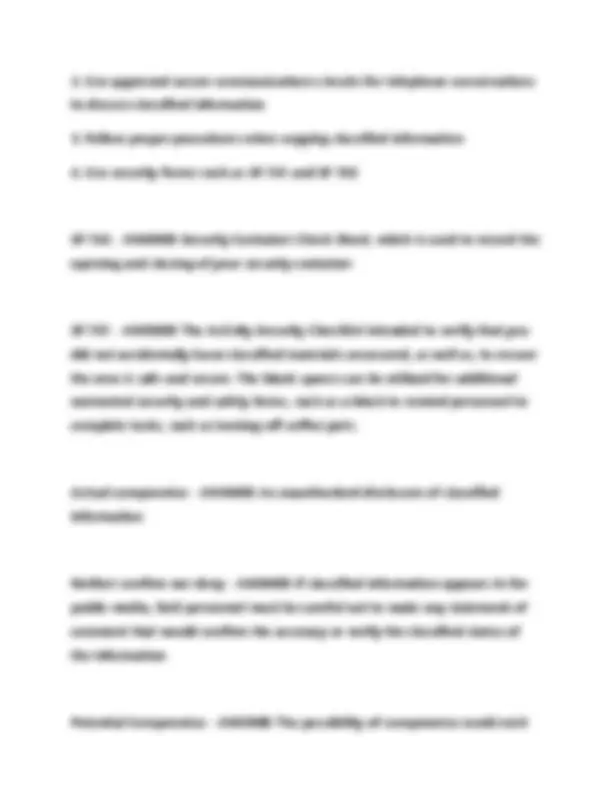
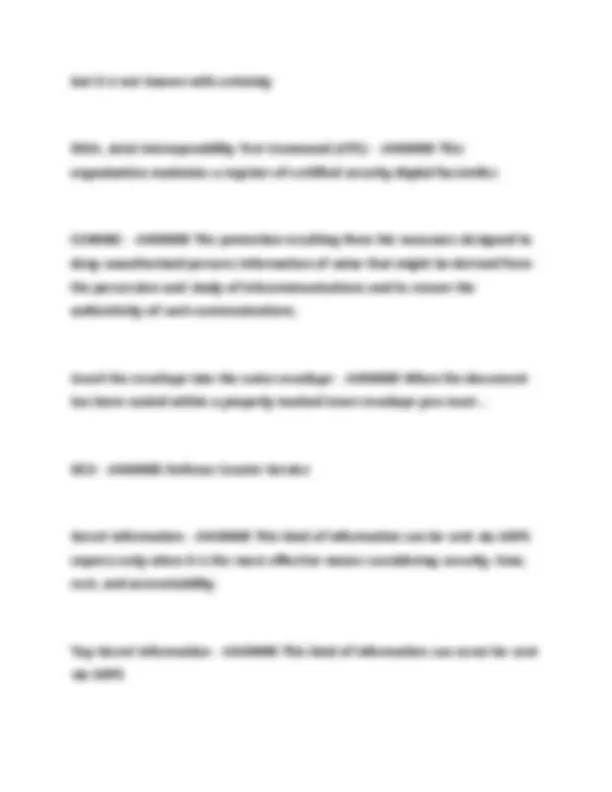
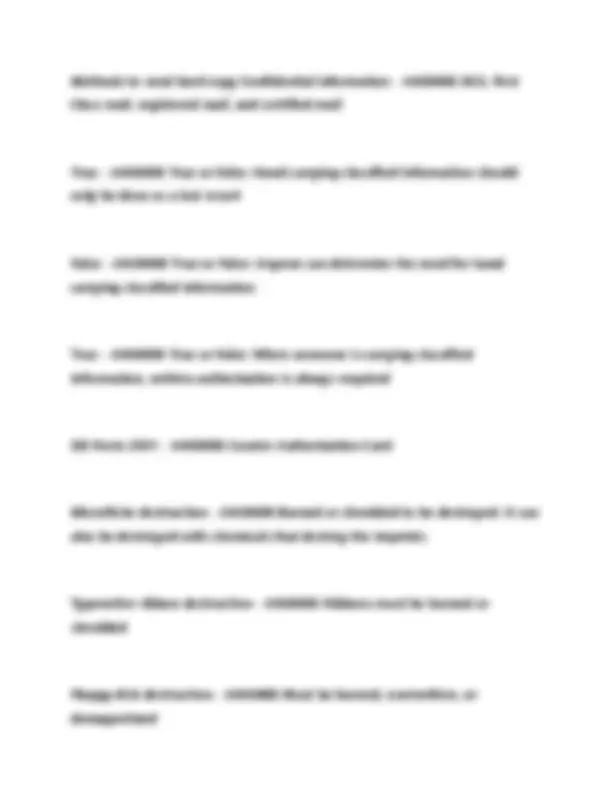
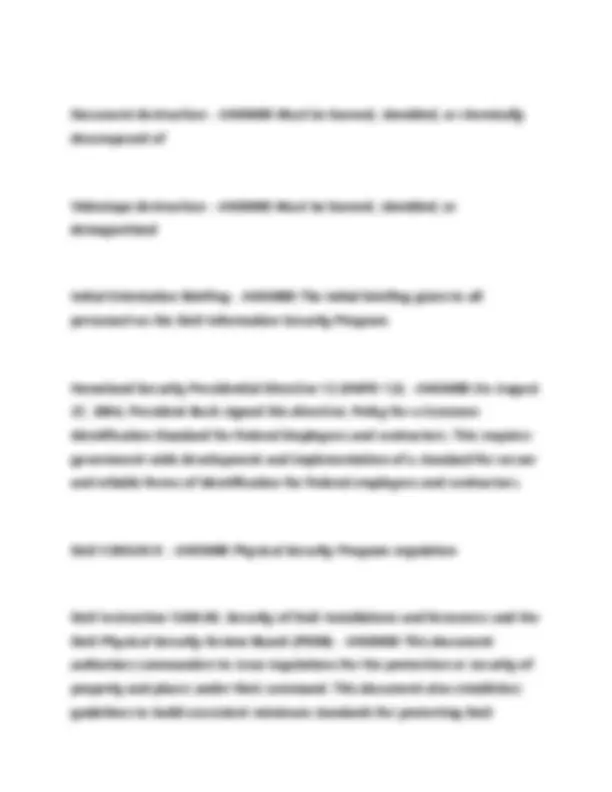



Study with the several resources on Docsity

Earn points by helping other students or get them with a premium plan


Prepare for your exams
Study with the several resources on Docsity

Earn points to download
Earn points by helping other students or get them with a premium plan
Community
Ask the community for help and clear up your study doubts
Discover the best universities in your country according to Docsity users
Free resources
Download our free guides on studying techniques, anxiety management strategies, and thesis advice from Docsity tutors
A q&a format overview of key concepts in department of defense (dod) security. it covers insider threats, special access programs (saps), critical program information (cpi), and related security procedures. The questions and answers offer a concise yet informative resource for understanding various aspects of national security and information protection within the dod.
Typology: Exams
1 / 37

This page cannot be seen from the preview
Don't miss anything!






























Principle incident/ events required to be reported to DoD counterintelligence (CI) organizations
should be considered in identifying Critical Program Information - ANSWER Elements which if compromised could:
- Individual must materially contribute to the program in addition to having the need to know; - All individuals with access to SAP are subject to a random counterintelligence scope polygraph examination; - Polygraph examination, if approved by the DepSecDef, may be used as a mandatory access determination; - Tier review process; - Personnel must have a Secret or Top Secret clearance; - SF-86 must be current within one year; - Limited Access; - Waivers required for foreign cohabitants, spouses, and immediate family members. Within Industrial Security: The SecDef or DepSecDef can approve a carve-out provision to relieve Defense Security Service of industrial security oversight responsibilities. Within Physical Security: - Access Control; - Maintain a SAP Facility;
- Access Roster; - All SAPs must have an unclassified nickname/ Codeword (optional). Within Information Security: - The use of HVSACO; - Transmission requirements (order of precedence).
Responsibilities of the Government SAP Security Officer/Contractor Program Security Officer (GSSO/ CPSO) - ANSWER From Revision 1 Department of Defense Overprint to the National Industrial Security Program Operating Manual Supplement - 1 April 2004:
- Possess a personnel clearance and Program access at least equal to the highest level of Program classified information involved. - Provide security administration and management for his/her organization. - Ensure personnel processed for access to a SAP meet the prerequisite personnel clearance and/or investigative requirements specified. - Ensure adequate secure storage and work spaces. - Ensure strict adherence to the provisions of the NISPOM, its
The four Cognizant Security Agencies (CSAs) - ANSWER Department of Defense (DoD), Director of National Intelligence (DNI), Department of Energy (DoE), and the Nuclear Regulatory Commission (NRC).
Cognizant Security Agencies (CSA)s' role in the National Industrial Security Program (NISP). - ANSWER Establish an industrial security program to safeguard classified information under its jurisdiction.
Critical Program Information in DoD - ANSWER 1. U.S. capability elements that contribute to the warfighter's advantage throughout the life cycle, which if compromised or subject to unauthorized disclosure, decrease the advantage.
technology or capability. Includes information about applications, capabilities, processes and end-items. Includes elements or components critical to a military system or network mission effectiveness. Includes technology that would reduce the U.S. technological advantage if it came under foreign control.
Primary authorities governing foreign disclosure of classified military information - ANSWER 1. Arms Export Control Act
The purpose of the DD Form 254 - ANSWER Convey security requirements, classification guidance and provide handling procedures for classified material received and/or generated on a classified contract.
Factors for determining whether U.S. companies are under Foreign Ownership, Control or Influence
and does not result in the loss, compromise, or suspected compromise of classified information
DoD Manual 5200.01, Volumes 1-4 - ANSWER The manual that governs the DoD Information Security Program
E.O. 13526 - ANSWER The executive order that governs the DoD Information Security Program
32 CFR Parts 2001 & 2003, "Classified National Security Information; Final Rule" - ANSWER The Information Security Oversight Office (ISOO) document that governs the DoD Information Security Program
Security Violation - ANSWER An event that results in or could be expected to result in the loss or compromise of classified information
Unauthorized Disclosure - ANSWER Communication or physical transfer of classified or controlled unclassified information to an unauthorized recipient
SSBI - ANSWER Initial investigation for military, contractors, and civilians: · Special-Sensitive positions · Critical-Sensitive positions · LAA · Top Secret clearance eligibility · IT-I duties
ANACI - ANSWER Initial investigation for civilians: · Noncritical-Sensitive positions · Confidential and Secret clearance eligibility · IT-II duties
NACLC - ANSWER Initial National Agency Check with Law and Credit for military and contractors: · Secret or Confidential clearance eligibility · All military accessions and appointments · IT-II duties · IT-III duties (military only)
DoD position sensitivity types and their investigative requirements. - ANSWER 1. Critical Sensitive
Investigative requirement for a Critical- Sensitive position - ANSWER SSBI, SSBI-PR, or PPR
Investigative requirement for a Non-Critical Sensitive position - ANSWER ANACI or NACLC
Investigative requirement for a Non-Sensitive position - ANSWER NACI
Revocation - ANSWER The term when current security clearance eligibility determination is rescinded
Denial - ANSWER The term when an initial request for security clearance eligibility is not granted
SOR - ANSWER Statement of Reasons
What is the purpose of the Statement of Reasons (SOR)? - ANSWER The purpose of the SOR is to provide a comprehensive and detailed written explanation of why a preliminary unfavorable adjudicative determination was made.
The 13 Adjudicative Guidelines - ANSWER 1. Allegiance to the United States
their families, installations, facilities, information, and other material resources from terrorist acts
Force Protection Condition levels - ANSWER Normal, Alpha, Bravo, Charlie, Delta
The concept of security-in-depth - ANSWER Layered and complementary security controls sufficient to deter, detect, and document unauthorized entry and movement within an installation or facility.
e-QIP - ANSWER The system Mr. Smith needs to access when he needs to update his personal information on his Personnel Security Questionnaire for his re-investigation
Personnel Security Investigation - ANSWER The first phase of the security clearance process
JCAVS - ANSWER A security manager uses this system to communicate with the DoD CAF
JAMS - ANSWER This sub-system (used by adjudicators) and JCAVS make up the JPAS system
JPAS - ANSWER A DoD system of record for personnel security clearance information
Scattered Castles - ANSWER Intelligence Community (IC) Personnel Security Database that verifies personnel security access and visit certifications.
Personnel Security Investigation (PSI) - ANSWER The DoD uses this as the standard for the uniform collection of relevant and important background information about an individual.
Access - ANSWER PSIs are used to determine the eligibility of an individual for ___________ to classified information.
Acceptance - ANSWER PSIs are used to determine the eligibility of an individual for ___________ or retention to the armed forces.
Assignment - ANSWER PSIs are used to determine the eligibility of an individual for ___________ or retention to sensitive duties.
False - ANSWER True or False: The DoD CAF is the only authority who can grant an interim clearance.
E.O. 12968 - ANSWER The Executive Order (E.O.) that establishes a uniform Personnel Security Program
DoD 5200.2-R - ANSWER Implements and maintains the DoD personnel security policies and procedures
USD(I) Memorandum, August 30, 2006 - ANSWER Defines the Adjudicative Guidelines
DCII - ANSWER This is a system of records of fraud investigations
SII - ANSWER This is a system of records of PSIs conducted by OPM
Scope - ANSWER This refers to when adjudicators must ensure that an investigation meets the minimum timeframe and element requirements before reviewing the investigation.
Administrative Judge - ANSWER During due process, military and civilian personnel may request an in-person appearance before this individual.
DOHA - ANSWER Administers due process for contractor personnel.
PSAB/Appeal Board - ANSWER This board makes the final appeal determination for all personnel
Termination Briefing - ANSWER This briefing is given when an individual's employment is terminated, clearance eligibility is withdrawn, or if the individual will be absent from duty for 60 days or more. It is also given to those who have been inadvertently exposed to classified information.
Foreign Travel Briefing - ANSWER This briefing that applies to cleared personnel who plan to travel in or through foreign countries, or attend meetings attended by representatives of other countries.
Refresher Briefing - ANSWER This briefing is presented annually to personnel who have access to classified information or assignment to sensitive duties.
What SAPs aim to achieve - ANSWER 1. Protect technological breakthroughs